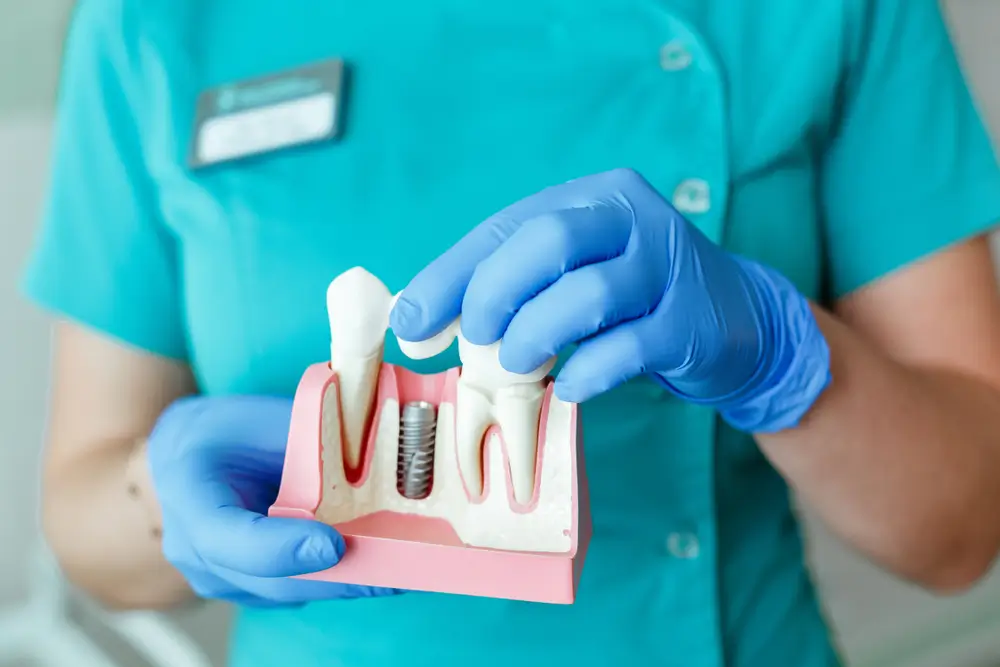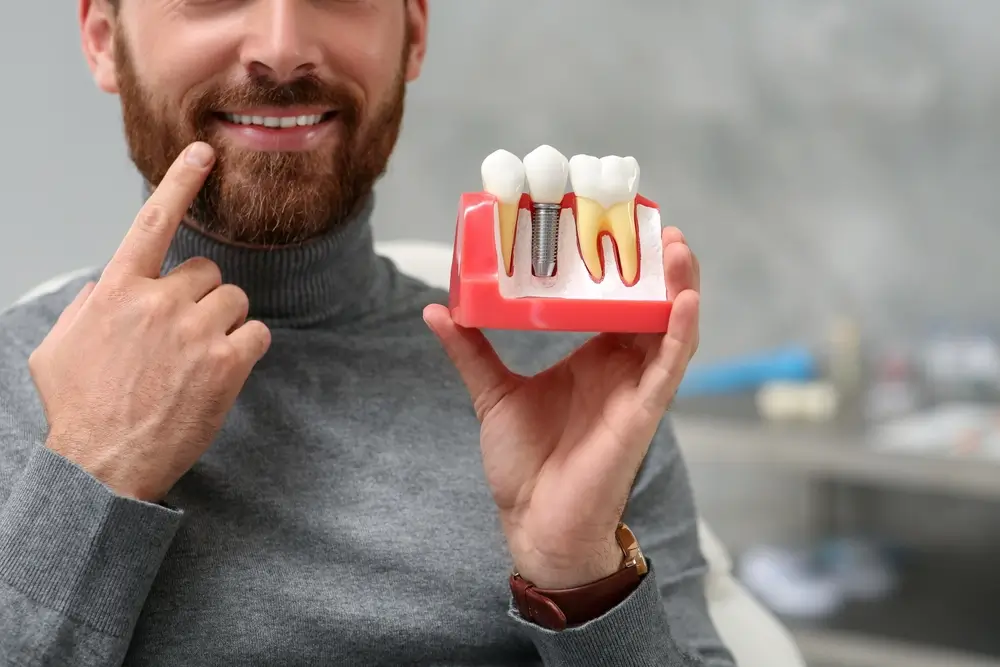Have you ever wondered what those natural-looking replacement teeth celebrities seem to get are? The answer is often endosteal implants, a popular and long-lasting solution for missing teeth.
In this post, we’ll explore what they are, how they work, and the many benefits they offer. Whether you’re considering replacing a single tooth or regaining a full, dazzling smile, this guide will equip you with the knowledge you need to make an informed decision.
What Is an Endosteal Implant?
An endosteal implant is a type of dental implant that functions as an artificial tooth root. Unlike dentures or bridges that sit on top of the gums, endosteal implants are surgically placed within the jawbone. Typically made of biocompatible titanium, these implants fuse with the jawbone over time, providing a strong foundation for a permanent restoration, like a crown, bridge, or even dentures.
Endosteal vs Subperiosteal Implant
There are two main types of dental implants: endosteal and subperiosteal. While endosteal implants are placed within the jawbone, subperiosteal implants rest on top of the jawbone, with posts that protrude through the gum tissue. Endosteal implants are generally preferred due to their stronger bond with the jawbone and higher success rates.

Who Are Ideal Candidates for Endosteal Implants?
Not everyone is a perfect candidate for endosteal implants, but they are a versatile option that works well for many people with missing teeth. Here’s a breakdown of the ideal characteristics checked during a consultation:
Overall Health
Generally, you should be in good overall health to undergo implant surgery. This means managing any chronic conditions and ensuring you can tolerate the surgical procedure.
Healthy Gums
Healthy gum tissue is crucial for successful implant placement. Your cosmetic dentist will assess your gums for signs of gum disease (periodontitis) and ensure they are healthy enough to support the implant.
Adequate Jawbone Density
Endosteal implants rely on a strong jawbone to fuse with for stability. Your jawbone density can be assessed through x-rays or 3D scans. If your jawbone has deteriorated due to missing teeth, bone grafting procedures might be needed before implant placement.
Commitment to Oral Hygiene
Maintaining excellent oral hygiene is essential for the long-term success of your implants. Brushing, flossing, and regular dental visits are key to preventing peri-implantitis, an infection around the implant.
Non-Smoker
Smoking can significantly hinder healing and increase the risk of implant failure. Quitting smoking before implant surgery is highly recommended.

Advantages of Endosteal Dental Implants
There are many advantages to choosing endosteal dental implants over other tooth replacement options. Here’s why you might consider endosteal implants for your smile:
Natural Look and Feel
Unlike dentures that can slip and cause discomfort, endosteal implants are permanently anchored in the jawbone, mimicking the function and stability of natural teeth. This translates to a natural look and improved chewing ability, letting you enjoy your food with confidence.
Enhanced Speech
Dentures can sometimes slip during conversation, causing slurred speech. Endosteal implants provide a stable foundation for speaking clearly and confidently, allowing you to express yourself freely.
Durability and Longevity
With proper care, endosteal implants can last a lifetime. They are much more durable than dentures, which may need to be replaced every 5-10 years due to wear and tear.
Improved Oral Health
Endosteal implants stimulate the jawbone, preventing bone loss that can occur after tooth loss. This helps maintain the health of your jaw and surrounding teeth.
Boosted Confidence
A beautiful, healthy smile can do wonders for your self-esteem. Endosteal implants can restore your confidence and allow you to smile brightly without worry.
Versatility
Endosteal implants can be used to replace a single missing tooth, multiple teeth, or even all your teeth. They can also be used to support bridges or dentures, providing a secure and stable fit.
Long-Term Investment
While the initial cost of endosteal implants may be higher than dentures, they are considered a long-term investment due to their durability and minimal need for replacements.
Endosteal Implant Procedure
The endosteal implant procedure is typically an outpatient process performed in stages over several months. Here’s a breakdown of what you can expect:
1. Consultation and Planning
This initial appointment lays the groundwork for your implant journey. A dentist will meticulously examine your mouth, teeth, and gums to assess your suitability for implants. X-rays or 3D scans will be captured to evaluate your jawbone density. This information is crucial for planning the precise placement of the implants to ensure optimal functionality and aesthetics. This initial visit is also your chance to discuss anesthesia options, what to expect during recovery, and the associated costs.
2. Implant Placement
Once the treatment plan is finalized, you’ll proceed to the implant placement surgery. Local anesthesia or sedation will be used to ensure your comfort throughout the procedure. The dentist will carefully make a small incision in your gum tissue to access the jawbone. Specialized tools are then used to precisely drill holes into the jawbone at the predetermined locations. The titanium implant post(s) will then be surgically placed into these prepared sites. Stitches may be used to close the gum tissue around the implant.
3. Healing Period
Following implant placement, a crucial healing period allows the jawbone to heal and fuse with the implants. This process, called osseointegration, typically takes several months. During this time, temporary restorations, such as a removable denture or crown, will be provided to maintain aesthetics and functionality while the implants integrate with your jawbone. The dentist will provide detailed instructions on proper care for the surgical site and your temporary restoration.
4. Abutment Placement
After successful osseointegration, you’ll return for another appointment. The dentist will remove the temporary restoration and attach a small connector piece called an abutment to each implant. The abutment acts as a bridge between the implant and the final restoration, such as a crown or bridge.
5. Crown Placement
The final stage involves attaching the permanent restoration, typically a crown, bridge, or denture, to the abutments. The dentist will meticulously ensure the fit, color, and shape of the restoration blend seamlessly with your existing teeth for a natural appearance.
Aftercare: What Happens After Dental Surgery?
Following implant surgery, your dentist will provide you with detailed aftercare instructions to ensure optimal healing and prevent complications. This typically involves maintaining good oral hygiene, following a soft diet, and attending follow-up appointments.
Bleeding and Soreness
It’s normal to experience some bleeding and discomfort in the first day or two. The dentist will give you gauze to manage any bleeding, and over-the-counter pain meds can help with soreness.
Puffy Face, Don’t Panic
Swelling around the implant site is common and usually peaks within 2-3 days. Apply an ice pack to the area for short periods throughout the day to keep the puffiness down.
Soft Food Diet
For the first few days after surgery, stick to soft foods that are easy to chew. Think mashed potatoes, yogurt – you get the idea. Gradually ease back into your regular diet as your mouth heals.
Brushing and Flossing
Keeping your mouth clean is super important, even after surgery. Brush and floss gently around the implant sites, following the dentist’s specific instructions. Avoid straws and smoking, as these can mess with healing.
Are Endosteal Dental Implants Painful?
Dental implant surgery itself is typically not painful. While some discomfort after the surgery is normal, any significant pain or persistent issues should be reported to your dentist right away. They can assess the situation and address any concerns you may have.

How Long Do Endosteal Dental Implants Last?
One of the biggest advantages of endosteal implants is their impressive longevity. Unlike dentures or bridges that may need to be replaced every 5-10 years, endosteal implants, with proper care, can last a lifetime!
Can Endosteal Implants Be Used To Replace Multiple Missing Teeth?
Absolutely! Endosteal implants are a fantastic option for replacing multiple missing teeth. Unlike dentures that can slip and cause discomfort, implants are strategically placed for a natural look and feel. Each missing tooth can have its own implant, providing individual support and preventing stress on surrounding teeth. Plus, implants stimulate the jawbone, promoting bone health and natural chewing function.
Need Dental Implant Surgery?
If you’re considering restoring your smile with endosteal implants in Houston, Dr. Saif Shere can help. Dr. Shere, Houston’s leading cosmetic dentist, is highly experienced in placing and restoring endosteal implants, offering the latest technologies and techniques to ensure a comfortable and successful experience.
Schedule a consultation with Dr. Shere at 9824 Fondren Rd, Houston, TX 77096 to discuss your options and see if endosteal implants are the right solution for your smile. With Dr. Shere’s expertise and personalized care, you can achieve a beautiful, healthy, and confident smile that lasts.